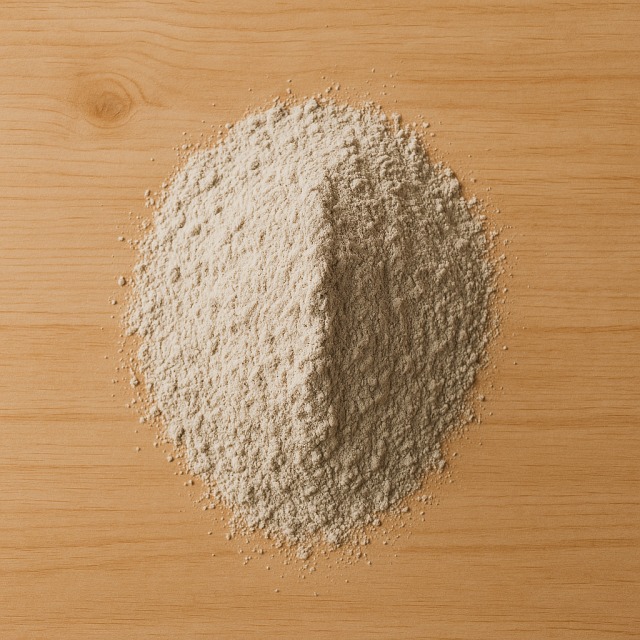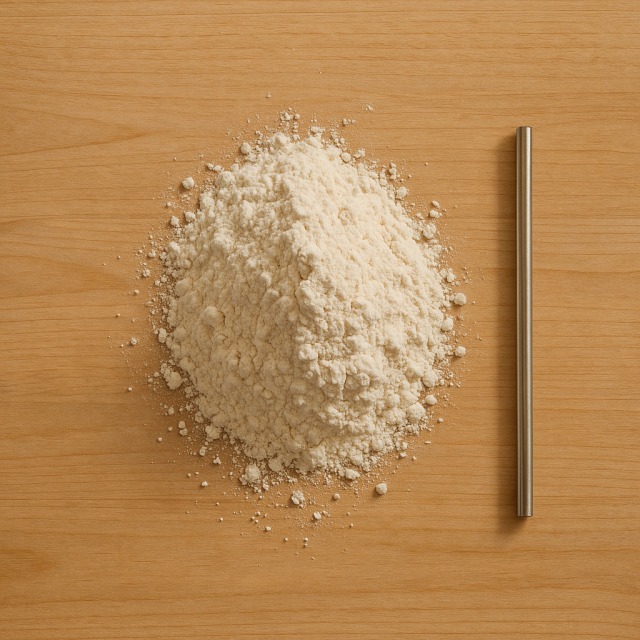Calorie Chart / Trimmings / Buckwheat flour
How Many Calories Are in Buckwheat flour?
Calculation of the nutritional value & Recommended Dietary Intake of buckwheat flour
For g and a calorie requirement of kcal
| Calories 323 kcal | Proteins 11 g | Lipids 2.3 g | Carbohydrates 65 g |
| 16% | 15% | 3% | 24% |
Health benefits of buckwheat flour

Buckwheat flour - 100g
Calories 323 kcal
Proteins 10.5 g
Lipids 2.3 g
Carbohydrates 65 g
Buckwheat flour is considered a moderate-calorie ingredient: with 323 kcal per 100 g, it supplies energy without reaching the very high calories of most nuts or oils. Thanks to its complex carbohydrates, it releases those calories gradually, helping to avoid sudden blood-sugar peaks.
It is naturally rich in magnesium, manganese, copper, and the B-vitamin group (especially B1 and B3). These micronutrients take part in hundreds of metabolic reactions that allow the body to turn calories into usable energy, maintain nerve function, and support immunity.
The flour also provides rutin and other flavonoids, compounds investigated for their supposed antioxidant and vessel-protective effects ("supposed" because human evidence is still limited). A good fibre content (around 10%) enhances satiety: you may feel full even though the calories are moderate. Finally, as it is gluten-free, buckwheat flour can diversify the cereal intake of people with coeliac disease while keeping their daily calories under control.
Historically, buckwheat arrived in Europe from Asia in the late Middle Ages; it became the base of the famous Breton galette and Russian blini. These traditional dishes prove that, when used wisely, the calories of buckwheat flour can fit into very different cultural diets.
Tips for incorporating buckwheat flour into a balanced diet
Because its calories come mainly from slow carbohydrates, buckwheat flour is ideal for breakfasts that keep you satisfied until lunch. Replace half the white flour in your usual pancake batter: you will obtain nutty crêpes with fewer rapid calories and more fibre.
For a balanced savoury meal, prepare Breton-style galettes filled with a poached egg, wilted spinach, and a slice of smoked salmon. The proteins of fish and egg slow down the absorption of the galette's calories while adding omega-3 and iron.
If you bake, mix buckwheat flour with 30% white flour to lighten the texture, or with ground almond for moist cakes that remain moderate in calories but richer in good fats. A spoonful of plain yogurt in the dough keeps it tender without extra butter—handy when you monitor daily calories.
Sportspeople can cook homemade energy bars: combine buckwheat flour, mashed banana, and honey, then bake until set. The result offers portable calories that release slowly during endurance sessions.
Frequently Asked Questions
- How many calories are in buckwheat flour?
- There are 323 kcal per 100 g.
- Is buckwheat flour lower in calories than white flour?
- Its calories are slightly lower (around −40 kcal per 100 g) and come with more fibre, which helps you feel fuller for the same calories.
- Does toasting buckwheat (kasha) change its calories?
- Toasting only removes a little moisture, so the calories per 100 g stay almost identical; the flavour, not the calories, is what changes.
- Can buckwheat flour help in a calorie-controlled diet?
- Yes: its fibre and protein make you satiated, so you may spontaneously eat fewer calories overall.
- Is buckwheat flour suitable for athletes needing extra calories?
- Absolutely. Combine it with high-protein food such as tofu or chicken breast in savoury pancakes to boost training calories in a nutritious way.
- Does buckwheat flour contain gluten even if the calories are similar to wheat?
- No, it is naturally gluten-free, making it a good alternative for coeliacs who still need sufficient calories for daily activities.
Similar foods
Information provided by Calorie Menu may contain inaccuracies or errors. It cannot, under any circumstances, substitute medical advice or medication.










